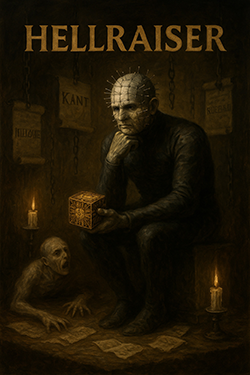
Hellraiser: A Kantian Case Study in Painful Aesthetics
Clive Barker’s Hellraiser isn’t so much a horror film as it is an Enlightenment-era ethics seminar gone profoundly wrong. Here, the Cenobites, those leather-clad philosophers of suffering, arrive not merely to rip flesh but to challenge our very understanding of pleasure, duty, and the categorical imperative. They do not torture so much as educate, offering what Kant never dared: the noumenal experience of pain itself.
Frank Cotton, our intrepid metaphysician of the flesh, opens Pandora’s Box, or as Schopenhauer might call it, the “Will to Disfigure.” In his quest for ultimate sensation, he discovers that the boundary between agony and ecstasy is as thin as human skin, and just as easily peeled away. The Cenobites, meanwhile, act as bureaucrats of metaphysical justice, ensuring that one’s curiosity about transcendence is always rewarded, with hooks.
Julia, ever the Nietzschean, transcends conventional morality through adultery, corpse restoration, and the aesthetic appreciation of damp basements. She is Überfrau in shoulder pads, proving that love, like ethics, is best explored through betrayal and blood.
Ultimately, Hellraiser asks the most important philosophical question of all: Is desire inherently self-destructive, or is self-destruction simply desire perfected? Barker’s answer is clear, when the boundaries of experience dissolve, enlightenment comes in chains.
If Sartre taught us that “Hell is other people,” Hellraiser retorts with latex precision: “No, Jean-Paul. Hell is yourself, disassembled and neatly arranged on hooks.”
